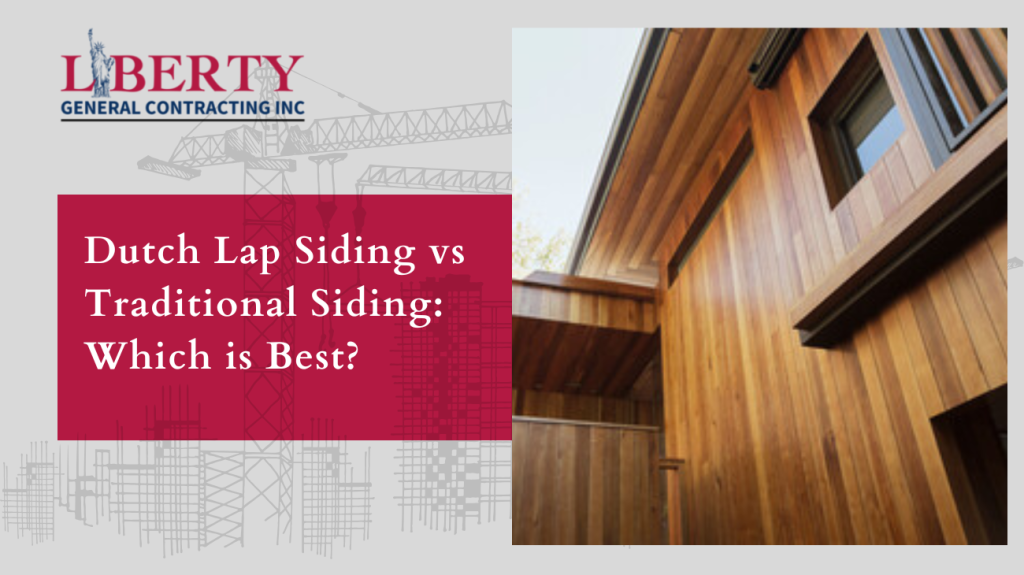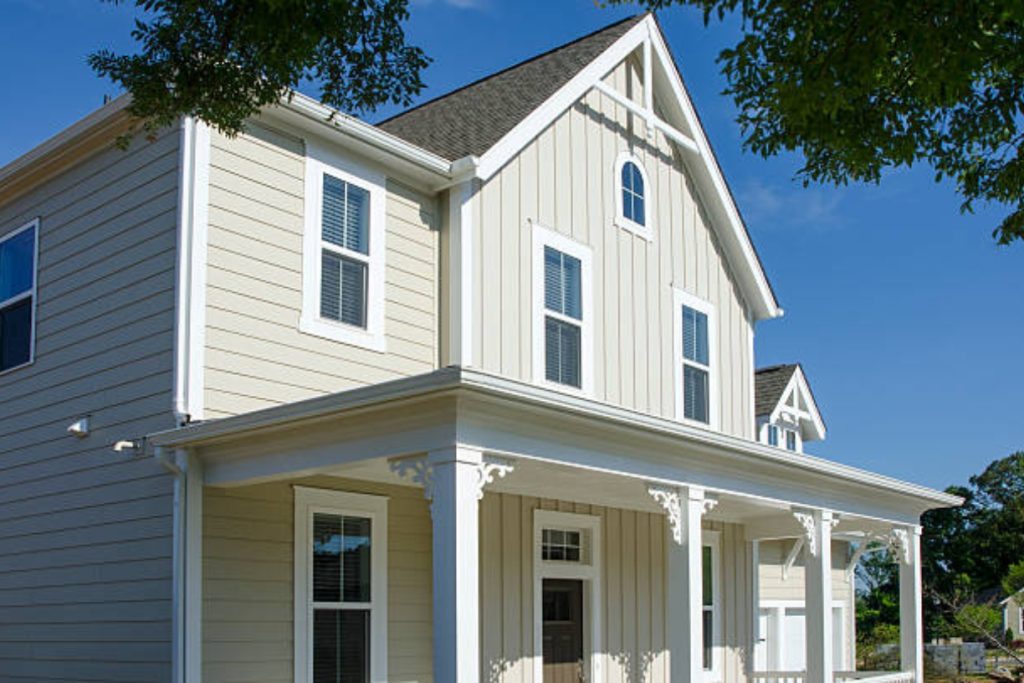When planning a home exterior upgrade, one of the biggest decisions is choosing the right siding style. Two of the most popular choices are Dutch lap siding vs traditional siding. Both have a classic look, reliable performance, and can dramatically improve your home’s curb appeal.
But how do you decide between Dutch lap siding vs traditional siding? This 2026 cost and style guide will help you compare both options in terms of appearance, durability, cost, and maintenance, so you can make the best choice for your home.
1. What Is Traditional Siding?
Traditional siding, often known as clapboard or straight lap siding, is one of the oldest and most common siding styles in America. It features long, narrow boards installed horizontally, with each board slightly overlapping the one below it.
This design helps water run off easily, keeping your home dry and protected. Traditional siding gives homes a clean, timeless, and smooth appearance, making it perfect for colonial, farmhouse, and contemporary homes.
Key Features of Traditional Siding:
- Flat, smooth panels
- Simple and elegant look
- Easy to install and maintain
- Works well with many architectural styles
2. What Is Dutch Lap Siding?
Dutch lap siding has a similar horizontal installation, but the boards have a curved notch or groove at the top. This creates a subtle shadow line that gives the siding a more textured and dimensional appearance compared to traditional siding.
Originally inspired by early American and Dutch architecture, Dutch lap siding has become a top choice for homeowners who want a more stylish, modern, and distinctive look.
Key Features of Dutch Lap Siding:
- Curved bevel that adds depth and shadow
- More decorative than traditional siding
- Hides seams better
- Enhances visual appeal and character
3. Visual Appeal: Style Comparison
When comparing Dutch Lap Siding vs Traditional Siding, appearance is often the biggest factor.
- Traditional Siding Look:
Simple and classic. The flat panels create a smooth and uniform surface, perfect for homeowners who prefer a traditional or minimalist design. - Dutch Lap Siding Look:
Adds dimension and depth. The beveled edge and shadow line make it look more elegant and refined. It’s often considered more luxurious and eye-catching than standard lap siding.
If you want a clean, timeless style, go with traditional siding.
If you want a richer, more textured design, choose Dutch lap siding.
4. Dutch Lap Vinyl Siding vs Traditional: Material Options
Both Dutch lap and traditional siding styles come in different materials such as vinyl, wood, fiber cement, and engineered wood. Among these, vinyl siding remains the most popular choice for homeowners in 2026 due to its low cost, minimal maintenance, and wide color variety.
Dutch Lap Vinyl Siding:
- More visually appealing due to the shadow lines
- Resistant to rot, insects, and fading
- Easy to clean and maintain
- Slightly higher cost than flat vinyl siding
Traditional Vinyl Siding:
- Smooth and classic design
- Simple installation process
- Available in many textures and colors
- More affordable option
When comparing Dutch lap vinyl siding vs traditional, Dutch lap often costs a bit more but provides a more upscale look that can boost home value.

5. Cost Comparison (2026 Estimates)
The cost difference between Dutch Lap Siding vs Traditional Siding depends on the material, brand, and labor costs in your area. Below are general 2026 estimates for vinyl siding installation:
| Siding Type | Average Cost per Sq. Ft. | Average Installed Cost for 1,500 Sq. Ft. Home |
| Traditional Vinyl Siding | $3.00 – $6.00 | $4,500 – $9,000 |
| Dutch Lap Vinyl Siding | $3.50 – $7.00 | $5,250 – $10,500 |
Why Dutch Lap Costs Slightly More:
- The design requires more precise cutting and alignment.
- Its stylish contour adds to the overall appearance, increasing demand.
However, both styles are budget-friendly, especially compared to wood or fiber cement siding.
6. Durability and Maintenance
Both siding types offer strong protection for your home, but there are some small differences worth noting.
Traditional Siding:
- Smooth surface makes cleaning quick and easy.
- Resistant to moisture when properly installed.
- May show seams more visibly over time.
Dutch Lap Siding:
- Curved design helps hide imperfections and seams.
- Slightly better at masking dirt and small cracks.
- Equal strength and weather resistance as traditional siding.
In 2026, vinyl siding technology has improved dramatically, making both Dutch Lap Siding vs Traditional Siding extremely durable, weather-resistant, and low-maintenance. A quick wash once or twice a year keeps them looking new.
7. Installation Differences
While installation methods are similar, Dutch lap siding requires a bit more skill because of its contoured shape.
- Traditional siding panels are flat and straightforward to align, making installation faster.
- Dutch lap siding needs precise placement to ensure consistent shadow lines and avoid uneven seams.
If you hire professional contractors like Liberty General Construction, you can expect expert installation for both types, ensuring a long-lasting, high-quality finish.
8. Energy Efficiency
Siding plays a big role in your home’s insulation and energy performance. Both dutch lap siding and traditional siding can be upgraded with insulated panels, which help reduce heat loss and energy bills.
- Traditional Siding with Insulation: Keeps a consistent interior temperature, especially in older homes.
- Dutch Lap Insulated Siding: Offers similar efficiency with a slightly tighter fit due to its contoured edges.
If you live in a region with cold winters or hot summers, insulated Dutch lap siding might be worth the extra cost.
9. Maintenance and Longevity
No matter which style you choose, both siding types are designed to last 20–40 years or more with proper care.
Maintenance Tips:
- Wash your siding annually using mild soap and water.
- Check for cracks or loose panels after storms.
- Avoid high-pressure washing to prevent damage.
Vinyl siding, whether Dutch lap or traditional, won’t rot or need painting. This makes it one of the most cost-effective long-term exterior materials in 2026.
10. Which One Adds More Home Value?
Curb appeal plays a major role in your home’s resale value. While both siding types can improve appearance, Dutch lap siding tends to give homes a more premium look.
If you plan to sell in the future, buyers may see Dutch lap siding as a design upgrade, helping your property stand out in a competitive market.
However, traditional siding is still a safe, classic option that never goes out of style.
11. Choosing Between dutch lap siding vs traditional siding
Here’s a quick summary to help you decide:
| Feature | Traditional Siding | Dutch Lap Siding |
| Appearance | Flat, smooth, simple | Curved, dimensional, decorative |
| Cost | More affordable | Slightly higher |
| Maintenance | Low | Low |
| Durability | Excellent | Excellent |
| Style Fit | Classic, timeless homes | Modern, upscale homes |
| Curb Appeal | Subtle | Eye-catching |
Best for homeowners who:
- Love simple, classic designs → Choose Traditional Siding
- Want depth, style, and uniqueness → Choose Dutch Lap Siding
12. Final Thoughts
When it comes to Dutch lap siding and traditional siding, there’s no wrong choice — it depends on your design preferences, budget, and home style.
If you prefer a smooth, traditional look, traditional siding is the perfect fit. But if you want to add depth and elegance to your home’s exterior, Dutch lap siding is worth the small extra cost.
At Liberty General Construction, we specialize in high-quality siding installation and exterior renovation services across New York. Whether you choose dutch lap siding and traditional siding, our expert team ensures a flawless finish built to last.
Get in touch today for a free siding consultation and discover which style best fits your home vision for 2026.
Contact Liberty GCNY
Website: www.libertygcny.com
Phone: (347) 682-9840
Serving: Manhattan, Brooklyn, Queens, The Bronx, Westchester County, and Long Island.
Address:110-14 178th St, Jamaica, NY
Need Help with Your Next Project? Call Liberty GCNY Today!
Fast responses. Expert advice. Trusted service across NYC and beyond.


